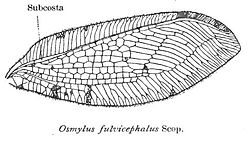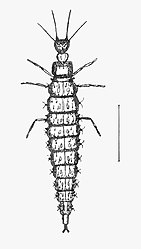Osmylidae
| Osmylidae | |
|---|---|

| |
| , Black Mountain, Canberra (Australia) | |
| Scientific classification | |
| Kingdom: | Animalia |
| Phylum: | Arthropoda |
| Class: | Insecta |
| Order: | Neuroptera |
| Family: | Osmylidae Linnaeus, 1758 |
| Subfamilies | |
|
| |
Osmylidae are a small family of winged insects of the net-winged insect order Neuroptera. The osmylids, also called stream lacewings[1] or giant lacewings[note 1],[2] are found all over the world. A common species through most of Europe is .
Description and ecology[]
Adult osmylids are small to moderately-sized net-winged insects, with wingspans ranging from 1.4 to 3 cm. Smaller members resemble typical green lacewings, and larger species resemble antlions. Many species, namely those of the type genus , have spotted wings. The thin antennae are short. They have two compound eyes, as well as three ocelli in between. Adult osmylids, like green lacewings (some of which are colloquially known as "stinkflies"), have prothoracal glands which produce foul-smelling compounds used to deter would-be predators.
Their larvae are superficially similar to those of spongillaflies (Sisyridae). They have peculiar mouthparts which look like a thin forceps with the ends bending outwards. The body is elongated and slender and terminates in two extensible graspers bearing tiny hooks; these are used to aid in locomotion and to grasp prey. The larvae are associated with damp, mossy habitats and are amphibious. They hunt small invertebrate prey, from which they suck the body fluids with their mouthparts.
The adults are diurnal or crepuscular weak-flying insects which mostly prey on small invertebrates, supplemented with some pollen. Eggs are deposited in damp places, usually near freshwater.

Wing of

Larva of
Systematics and taxonomy[]
The osmylids are rather nondescript as adults, but among the Neuroptera they were generally assigned to suborder Hemerobiiformia (lacewing relatives). The Sisyridae (spongillaflies) were formerly believed to be closely related, even a sister group. But as it seems they are well distinct, the presumed close relationship being mistaken due to their larvae's superficial similarity caused by convergent evolution. Later, the green lacewings (Chrysopidae) were held to be the osmylids' closest living relatives; together with some prehistoric lineages the Chrysopidae form superfamily Chrysopoidea which was considered sister to the presently monotypic Osmyloidea.[citation needed] However, mitochondrial DNA data found the Osmylidae to be basal to these as well as to the Myrmeleontiformia.[3] In other words, the osmylids may be the most ancient living lineage of Neuroptera. Fossils described in 2016 indicate they are of Jurassic or Early Cretaceous origin (see below). Their relationships to the numerous incertae sedis groups of Mesozoic Neuroptera can now be reinvestigated with regard to this hypothesis.[3]
The two subfamilies and each contain only a single species, and , respectively. Both are endemic to Australia. Eight fossil genera have been assigned to the living subfamily , with from middle Eocene Baltic amber,[4] as the type genus.[5] The genus Burmaleon was described from two fossils found in Cenomanian age Burmese amber and referred to subfamily , implying an Early Cretaceous or earlier age for the crown group radiation.[6]
Notes[]
References[]
- ^ Güsten, Robert (2003). "A checklist and new species records of Neuropterida (Insects) for Tunisia" (PDF). Kaupia: Darmstädter Beiträge zur Naturgeschichte. 12: 129–149. Retrieved 10 July 2021.
- ^ "Osmylidae". Fauna Europaea. Retrieved 28 February 2017.
- ^ Jump up to: a b Yan, Y.; Wang Y; Liu, X.; Winterton, S.L.; Yang, D. (2014). "The First Mitochondrial Genomes of Antlion (Neuroptera: Myrmeleontidae) and Split-footed Lacewing (Neuroptera: Nymphidae), with Phylogenetic Implications of Myrmeleontiformia". Int J Biol Sci. 10 (8): 895–908. doi:10.7150/ijbs.9454. PMC 4147223. PMID 25170303.
- ^ Engel, M.S.; Grimaldi, D.A. (2007). "The neuropterid fauna of Dominican and Mexican amber (Neuropterida, Megaloptera, Neuroptera)". American Museum Novitates (3587): 1-58. PDF fulltext
- ^ Makarkin, V.N.; Archibald, S.B.; Mathewes, R.W. (2021). "New Protosmylinae (Neuroptera: Osmylidae) from the early Eocene of western North America, with taxonomic remarks". Zootaxa. 4980 (1): 142–156.
- ^ Myskowiak, J.; Huang, D.; Azar, D.; Cai, C.; Garrouste, R.; Nel, A. (2016). "New lacewings (Insecta, Neuroptera, Osmylidae, Nymphidae) from the Lower Cretaceous Burmese amber and Crato Formation in Brazil". Cretaceous Research. 59: 214. doi:10.1016/j.cretres.2015.10.029.
External links[]
- This article draws heavily on the corresponding article in the German-language Wikipedia.
![]() Media related to Osmylidae at Wikimedia Commons
Media related to Osmylidae at Wikimedia Commons
- Neuroptera
- Neuroptera families

